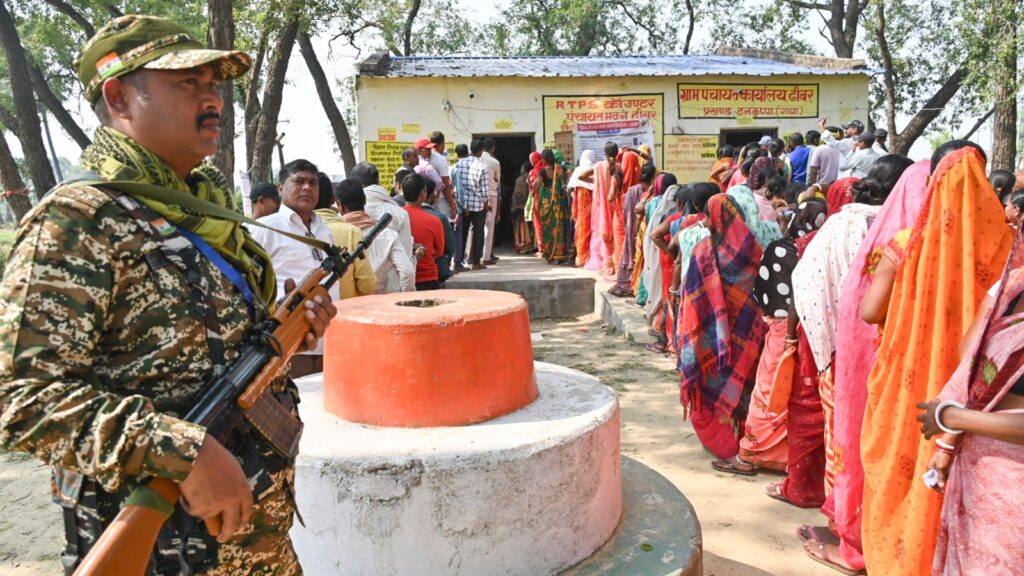As the constituency of Barbigha in Bihar’s Sheikhpura district went to the polls on November 6, The Indian Express asked villagers there what they were voting for. The motley group of men from the Extremely Backward Classes (EBCs), Paswans, and Manjhi communities (the latter two are Dalit groups) discussed the improved roads, the need for employment, and law and order.
Most of them predictably leaned towards the NDA, given that their communities are on the ruling alliance’s side. Asked if there were Hindu-Muslim fissures here, one in the group, Ramesh Paswan, said, “Yahaan aisa kuchh nahin hai (there is nothing like that here).”
Under Chief Minister Nitish Kumar for 20 years now — and largely with the BJP as the key, and sometimes the electorally more successful ally — Bihar has seen a new NDA experiment. Despite the BJP being powerful in the state, there is a “bijli, sadak, paani” NDA with very little scope for Hindutva, stray statements by a leader such as Union Minister Giriraj Singh notwithstanding. In other states where the BJP is powerful, Hindutva adds a cultural layer to the “development” pitch that has become the hallmark of how the Narendra Modi government frames itself.
To the west of Bihar lies Uttar Pradesh, a state where the rise of the BJP and the NDA has also meant the rise of Hindutva. To the east is West Bengal, where the BJP’s rise — though the party fell short in its quest for power in 2021 — has also led to the strengthening of Hindutva, with Ram Navami celebrations creating political controversy almost annually. And further to the east lies Assam, where, again, the rise of the BJP has brought a dash of Hindutva, the latest being a bid to outlaw polygamy for all communities, except tribals, meaning that Muslims aren’t exempt unless they resided in a Scheduled Area since before 2005.
The NDA may not have a pronounced Hindutva component in most southern states (Karnataka is an exception), but that is easily explained as the BJP is weak there. In Bihar, by contrast, a strong BJP notwithstanding, the NDA has till now eschewed Hindutva when in power.
Social justice of material upliftment
Apart from bread-and-butter issues, caste combinations trump matters of religion in Bihar, but even here, there is a distinctive Bihar pattern that has a Nitish Kumar stamp. Caste is largely mobilised not in terms of caste pride but as the locus of the welfare policies reaching intended groups. This is qualitatively different from the Sangh Parivar’s mobilisation of deprived caste and tribes over several decades, where their heroes are constructed as Hindu heroes.
In villages across several constituencies, people belonging to caste groups with the NDA — be it sections of Dalits, EBCs, Other Backward Classes (OBCs), or the upper castes — talked about the “transformation” of Bihar in terms of roads, power supply, flyovers and law and order as the reason for supporting the ruling alliance. Many among the most deprived castes, such as the Musahars, cited free grain and the recent transfer of Rs 10,000 in the accounts of women as part of the Mukhyamantri Mahila Rojgar Yojana.
Be it the EBCs, a category created in the late 1970s by Karpoori Thakur but nurtured by Nitish Kumar, or the Mahadalits, material upliftment and welfare, rather than pride, defined the popular circulation of these caste categories. The Dalit cultural assertion in, say, Punjab, where music is produced to celebrate those from the leather working castes, or the celebration of Dalit-Bahujan icons such as Uda Devi Pasi, Jhalkari Bai, or Raja Suheldev is largely absent in Bihar. Caste has been primarily mobilised under Nitish as a medium through which the state claims to empower what it sees as previously deprived groups.
The Opposition’s criticism of the NDA also takes the same line, with those desiring change also framing it in terms of social welfare and development. Given Bihar’s history of underdevelopment and lack of urbanisation — the state was 89% rural as per the 2011 Census — the primary concern across castes and religions, and across party lines, is basic development. While the same is partially true for UP as well, the state differs from Bihar as it is the site of several enduring religious disputes, such as Kashi, Mathura, and the recently resolved Ram Janmabhoomi dispute.
Some Hindutva subtext
The only region of Bihar where a Hindutva subtext is sometimes visible in casual conversations is Seemanchal, where large Muslim populations co-exist with Hindu settlements.
In Kusaila in Seemanchal’s Katihar district, Hindutva emerged as a default subtext in interactions with a group of people from the Mandal community, categorised as EBC in the state. The Mandals are NDA supporters and praised Nitish Kumar, predicting his return. However, digressing from the tone and tenor of the conversation, local resident Dineshwar Mandal said Muslim settlements were nearby and these might have “beef eaters”. Those around him nodded.

